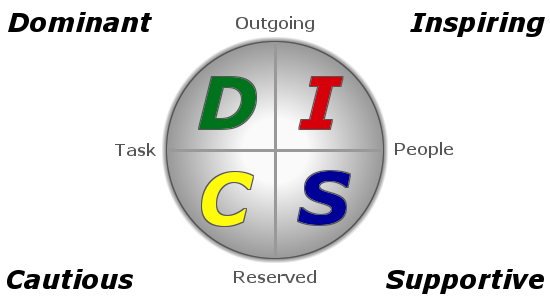-
Behavior Category 1 Active and Decisive (D)
“She was always active, even as a baby she couldn’t sit’ still” -
Behavior Category 2 Talkative and Animated (I)
“He’s always be talkative. His report cards always had a comment from his teacher about how disruptive his taking was in class” -
Behavior Category 3 Soft-spoken and Cooperative (S)
“He was always such a good, quiet child. He never gave me a bit of trouble.” -
Behavior Category 4 Cautious and Concerned About Doing Things Correctly
“He always asked what to do first before acting.”
No one style is better than another they are just different ways of behaving. Each style has both strengths and weaknesses. Most children are able to use behaviors from all four styles even though they prefer 1 or 2 styles.
-
The essence of this model is based on human emotion. In other words, we don’t intend to provide meaningful insights about such aspects as
spirituality, competency or intellect. -
To understand this model more, it is good to go back to its predecessors. During the period of the Ancient Greeks, 4 behavioral temperaments
were referred to:
Choleric (yellow bile) = D
Sanguine (blood) type = I
Phlegmatic (black Bile) type = S
Melancholic (Black Bile) type = CThe model represents accumulated insights of many people. The same theory finds expression in the 4 main blood groups (A, B, AB and O).
BEHAVIORAL CHECKLIST
The following checklist can be used to develop an understanding about the children in your life. To determine a child’s natural behavioral style, just read through the descriptions. Put a check mark next to the phrases which best describe the child’s most common behaviors. As you read through the checklist, think about the most common behaviors you have observed.
Behavioral Category 1
- This child prefers to communicate directly, quickly and to tell you what he or she wants.
- This child usually acts forcefully and boldly.
- This child can usually hold his or her ground with children his or her own age and even with some adults.
- This child is willing to take risks.
- This child is less dependent on help and often prefers to do things himself or herself.
Behavioral Category 2
- This child acts enthusiastically in most situations.
- This child may act spontaneous and carefree.
- This child finds others interesting and likes to be with people.
- This child acts an outgoing manner and meets people easily.
- This child may be sentimental or have emotional highs and lows.
Behavioral Category 3
- This child acts patiently in most situations.
- This child usually listens more than talks.
- This child tends to be cooperative and usually gets along with others.
- This child is seen as easy-going.
- This child is less active toward trying new things and usually prefers the old or familiar.
Behavioral Category 4
- This child is usually conscientious and concerned about doing things right.
- This child is cautious in most situations.
- This child likes to think things through.
- This child likes privacy and may like to play alone.
- This child is usually diplomatic.
Count the number of checks you made in each category. Determine which two categories have the most checks.
BEHAVIORAL CATEGORY 1 : ACTIVE & DECISIVE (D)
- Hate to lose
- Somewhat demanding
- May ask a lot of questions
- Controls the environment by being the “boss”
- Often tells instead of asks
- Not afraid to barge in
- Not afraid to fight for what they need or want
- Have the drive to do things quickly
- In the classroom, may have trouble sitting for long periods of time
- Have a natural drive for activity
- If forced to sit still for long periods of time, may “stir up trouble”
BEHAVIORAL CATEGORY 2 : TALKATIVE AND ANIMATED (I)
- May like to show off or be the center of attention
- Able to get most people to listen to them talk
- Usually make friends very easily and can be quite charming
- Tend to want popularity and recognition
- Know how to get attention and can easily talk to almost anyone
- Interacts with all types of people
- “her his talking frequently disrupts the class”
- Always volunteers to answer questions
BEHAVIORAL CATEGORY 3 : SOFT SPOKEN AND COOPERATIVE (S)
- probably dislikes fighting
- prefers to cooperate with others
- tend to be soft spoken and quiet
- usually try hard to see the good in people; takes pride in being pleasant to others
- like things and people to stay just the way they are
- prefers to listen
- may allow other children to get the attention or center stage
- do not have to be the star but like sincere recognition
- frequently commended in school because of ability to get along with other children and be part of a team
- good at listening, cooperating
BEHAVIORAL CATEGORY 4 : CAUTIOUS AND CONCERNED ABOUT DOING
- like to do things correctly
- like to plan ahead and know what the rules are
- prefers to know the exact answers
- like their rooms organized and neat
- usually like to have time to think before deciding to do anything
- may sometimes fret and worry
- careful with key details such as taking care of favorite toys
- asks probing questions which seem too adult for them
- careful in doing tasks
- follows rules






